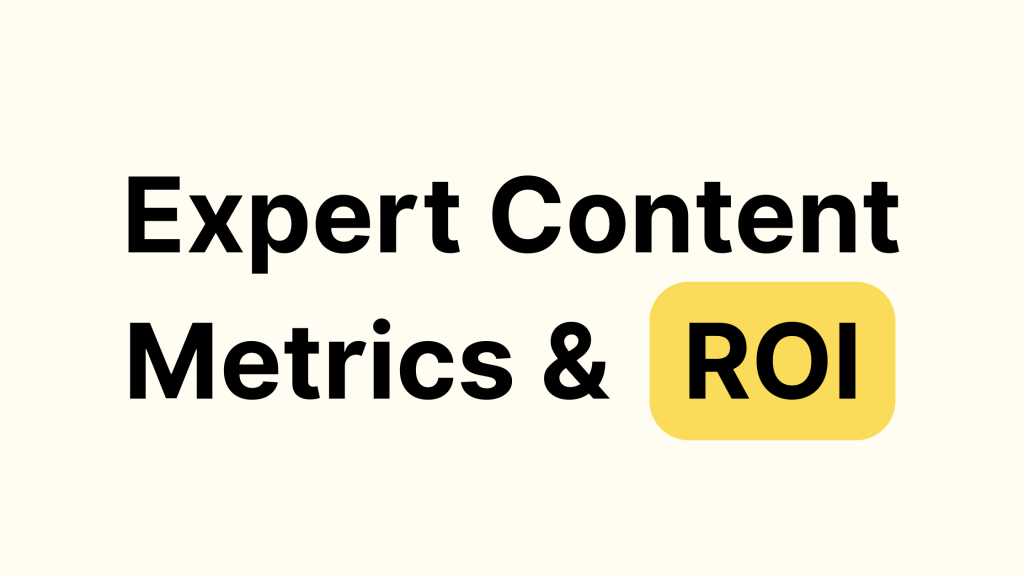Expert Content Metrics & ROI: How to Measure What Matters
By Giuseppe Colucci, Senior VP of Growth at Textbroker & Uta Leyke-Hess, Senior SEO Consultant

We all love to say it: “Expert content builds trust.” But how often do we actually measure whether that trust translates into better performance? AND: Which metrics shall be used to measure that? How can we ensure consistent results?
In a world where SEO success is increasingly tied to authority and credibility (thanks, E-E-A-T), many teams are investing in expert-written content: Subject-Matter Experts (SMEs) – the abbreviation “SME” is not to be mixed up with “Small/Medium Enterprises – either write and author or review content and guarantee its quality with their “reputational name and bio”. Additionally, interviewing experts adds authority and trust to your website’s content.
However, it is not as easy as one could imagine to track whether it performs better than content from anonymous or non-authoritative authors.
So, here is our practical approach to how we (and you) can measure the impact of expert content and prove its ROI.
Before we start, here is one additional element to bear in mind: this type of content is meant to generate performance ROI, not just in terms of “traditional SEO” metrics, like traffic uplift or rankings (goodbye, good old Google search experience!). But also, in terms of KPIs related to strengthening brand authority and awareness (welcome, new SGE!).
First, What Counts as “Expert” Content?
Let’s define what we mean:
We’re talking about content written by SMEs—ideally, named individuals with credentials and recognized experience in the field. This might be a medical doctor, lawyer, engineer, tax advisor, or even a founder with deep operational insight.
At Storylake, we hire SMEs and create authoritative content, for example, with Dr. Elisabeth Vatareck, who writes for Doctolib on healthcare topics, drawing on her professional background in medical content and communications. Similarly, Chris Skinner contributes to SumUp’s business content, helping readers navigate topics such as payments, POS systems, and entrepreneurship from a position of real-world knowledge.

In contrast, ghostwritten or anonymous content may be well-written but lacks that clear trust signal.
This distinction also matters to Google. According to its Search Quality Evaluator Guidelines (Section 3.3.4), raters are encouraged to look for signs of author credibility, including:
- biographical details
- educational degrees
- peer validation
- expert co-authors
- citations
- employment history.
In other words: real experts leave real footprints.
As content strategist Diana Kelly Levey writes in her guide to expert content, SMEs add “trustworthiness” and “authoritative heft” to your content – especially when paired with accessible language and consistent messaging.
She shares examples like Embark, a dog DNA company that uses veterinarians as blog authors, and ButcherBox, which partnered with a chef for YouTube tutorials. The key takeaway? Having experts on paper isn’t enough: what matters is weaving them meaningfully into your brand voice and customer journey.
Real experts leave real footprints.
Metrics That Actually Reflect Expert Value
So, what should you track to understand whether expert content is paying off?
As the content landscape evolves, it’s no longer just about ranking in Google. While classic SEO metrics still matter, LLMs like ChatGPT, Gemini, and Perplexity are increasingly shaping how users discover and trust information.
To help you cover both angles, we’ve split the most relevant KPIs into two practical tables:
- Table 1: Traditional SEO & Google-centric metrics
- Table 2: LLM-era trust and visibility metrics
Whether you’re running a full pilot or just benchmarking a few articles, the following breakdowns offer a clear starting point for what matters today and what’s coming next.
Table 1: Google-centric Expert Content KPIs
| KPI | What It Shows | How to Measure It | Example or Tip |
| Time on Page | Are people actually reading the content? | Use Google Analytics or similar. Check avg. time per article. | SME articles might average 2:45 vs. 1:10 for generic content of the same length |
| Scroll Depth | Are readers consuming most of the content? | Use scroll tracking tools (GA4, Hotjar, etc.). | Aim for 75%+ scroll on in-depth SME posts. |
| Bounce Rate | Are readers leaving after just one page? | GA4 → “Engaged Sessions.” Lower is better. | A low bounce rate (<50%) suggests the content is useful. |
| Ranking Stability | Does the content stay in the top positions? | Use tools like Ahrefs or Semrush over 3-6 months. | SME content often ranks more consistently for YMYL topics. |
| Featured Snippets & Rich Results | Is Google rewarding the content with visibility? | Check via search or SEO tools. | SME answers often surface as “People Also Ask” results. |
| Internal Linking Engagement | Are readers exploring related content? | Track link clicks via GA or heatmaps. | Add contextual links to relevant, expert-backed articles. |
| Backlinks | Do others cite the content as trustworthy? | Use Ahrefs, Semrush, or GSC’s “Links” section. | Expert content tends to earn more natural, high-quality links. |
Table 2: LLM-era Expert Content KPIs
| Reputation Lift | Is your brand seen as a thought leader? | Qualitative: mentions, brand searches, social validation. | Monitor LinkedIn comments, speaker invites, or press quotes. |
| Higher-Quality Leads | Are leads better qualified or more conversion-ready? | CRM/lead scoring tools or sales feedback. | Experts help attract informed, serious prospects. |
| Gated Asset Conversions | Do SME articles drive downloads or signups? | Track CTA conversions from article to lead magnet. | Test expert vs. generic intros leading to the same asset. |
| Assisted Conversions | Did the article influence conversion later? | Use GA4 conversion paths or multi-touch attribution. | Track when SME content is viewed early in the customer journey. |
| AI Referrals | Are users finding your site via AI-powered tools? | Check referral sources in GA4 or similar. Look for domains like “chat.openai.com” or “perplexity.ai.” | Compare session duration and conversions from AI referrals vs. organic traffic. |
| Mentions in LLM Responses | Is your brand cited by tools like ChatGPT or Perplexity? | Run branded prompts manually or use monitoring tools. | Ask: “What’s a good source for [topic]?” to see if your brand/content is referenced. Track over time for key topics. |
| SGE Visibility (Google) | Is your content selected by Google’s AI Overviews (SGE)? | Use tools or manual searches in SGE-enabled environments. | Check if your content appears in SGE summaries and how it’s phrased. |
Why Not Simply Make Up The Author’s Expertise?
The Cost of Fake Bios
This whole SME-written content thing isn’t just about performance gains: it’s also about protecting your brand.
In April 2025, Press Gazette revealed that major publishers like Yahoo News and the Mirror had quietly deleted dozens of articles after it emerged they’d quoted fake “experts” – often AI-generated personas promoting products like CBD oil, sex toys, vapes, or essay-writing services.
The fallout was serious: stories were pulled, PR platforms issued warnings, and editorial teams had to reassess their sourcing processes. The lesson? Credibility is a long game – and once it’s lost, it’s hard to win back.
How to Calculate ROI of Expert Written Content
Here’s a simple formula to start with:
ROI = (Attributable Gains / Content Cost) * 100If you can directly tie revenue or leads to a specific expert article – great! But often, the impact is more indirect. In that case, use proxy metrics like:
- Improved lead quality
- Higher search visibility
- Lower bounce rates
- Increased backlinks or brand mentions
- Coverage in newsletters or PR
Even a simple A/B test (expert vs. non-expert content on similar topics) or a content audit can help uncover where SME-driven content performs better.
However you measure it, the key is to start—and to measure consistently.
